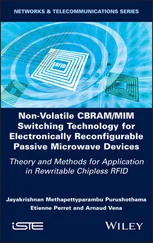Joel P. Dunsmore - Handbook of Microwave Component Measurements
Здесь есть возможность читать онлайн «Joel P. Dunsmore - Handbook of Microwave Component Measurements» — ознакомительный отрывок электронной книги совершенно бесплатно, а после прочтения отрывка купить полную версию. В некоторых случаях можно слушать аудио, скачать через торрент в формате fb2 и присутствует краткое содержание. Жанр: unrecognised, на английском языке. Описание произведения, (предисловие) а так же отзывы посетителей доступны на портале библиотеки ЛибКат.
- Название:Handbook of Microwave Component Measurements
- Автор:
- Жанр:
- Год:неизвестен
- ISBN:нет данных
- Рейтинг книги:5 / 5. Голосов: 1
-
Избранное:Добавить в избранное
- Отзывы:
-
Ваша оценка:
- 100
- 1
- 2
- 3
- 4
- 5
Handbook of Microwave Component Measurements: краткое содержание, описание и аннотация
Предлагаем к чтению аннотацию, описание, краткое содержание или предисловие (зависит от того, что написал сам автор книги «Handbook of Microwave Component Measurements»). Если вы не нашли необходимую информацию о книге — напишите в комментариях, мы постараемся отыскать её.
Handbook of Microwave Component Measurements — читать онлайн ознакомительный отрывок
Ниже представлен текст книги, разбитый по страницам. Система сохранения места последней прочитанной страницы, позволяет с удобством читать онлайн бесплатно книгу «Handbook of Microwave Component Measurements», без необходимости каждый раз заново искать на чём Вы остановились. Поставьте закладку, и сможете в любой момент перейти на страницу, на которой закончили чтение.
Интервал:
Закладка:
During the design phase, full characterization of performance, including amplitude and phase, is a must in order to establish a reference for future production runs. So it becomes a necessary requirement to characterize and de‐embed the test setup and test fixtures to isolate actual device performance. Fortunately, the modern vector network analyzer provides support in this regard. Consequently, the performance data obtained during the design phase becomes the gold standard for evaluating statistical variation obtained from future production lots; and these lots are accepted or rejected based on the statistical results, with sigma generally being the statistic most closely watched by the test or QA engineer to evaluate production lot acceptance.
When published specs are provided for a component, it is very important to understand that these specifications are simply markers which allow for a first impression or summary review of the component performance. However, only when performance data and performance graphs are provided for all parameters, including both amplitude and phase, would the “real” performance of the component be known. Furthermore, in characterizing components for use in customer evaluations, it is important to provide this data both within and outside the specified bandwidth. In non‐linear components such as a frequency mixer, higher‐order harmonics of the RF and LO signals are generated, and depending on the load impedance outside the specified frequency range, these higher‐order harmonics can get reflected back into the mixer, causing an interaction between the desired signals and the unwanted harmonics. Fortunately, modern‐day analyzers can make these harmonic measurements relatively quickly and easy.
Dr. Dunsmore has captured the essence of modern‐day measurements. He provides a practical understanding of measurement capabilities and limitations. He provides a means for the test engineer to not only make measurements, but also to understand test concepts, anticipate measurement results and learn how to isolate and characterize the performance of the DUT, independent of potential errors inherent in the test environment. I am confident that this book will serve as a reference for understanding measurement methods, test block diagrams and measurement limitations so that correlation between the manufacturer and user would take place by using a common reference. This book has the potential to be an invaluable source to further the progress of the RF and microwave world.
Harvey Kaylie
President and Founder of Mini‐Circuits
Preface to the Second Edition
It has been seven years since the first edition of this book, and while the fundamentals of RF and microwave component measurement (and thus the fundamental chapters) are largely unchanged, the advent of new methods and technologies has greatly increased the capabilities of the vector network analyzers, furthering the trend to fully integrated test solutions for complete component characterization.
Chapter 1has been updated with better measurements of high‐frequency connectors (3.5, 2.4, 1.85, and 1 mm) showing their response and moding characteristics, as well as adding some discussion on new modulation measurements such as noise power ratio (NPR) and adjacent channel power ratio (ACPR).
Chapter 2adds new material on multiport network analyzers with very large port counts and new broadband mm‐wave network analyzers.
Chapter 3has been somewhat simplified with respect to details of power calibration (deleting some obsolete methods). Added were details on in‐situ calibration modules (CalPods), a new concept of calibrating multiple channels and measurements with a single calibration (i.e. cal‐all), and a new discussion of real‐time uncertainty capability.
Chapter 4's theoretical material is unchanged (the Fourier transform remains as it was), but a new section on simulated time‐domain reflectometer (TDR) measurements including eye diagrams has been added.
Chapter 5is essentially unchanged, with just some minor updates.
Chapter 6keeps the basics of amplifier test unchanged but adds several new topics including improved harmonic measurement methods, a method for testing dual input Doherty‐type amplifiers, an updated discussion of X‐parameters, and a new discussion of active or Hot S‐parameters. The topic of distortion measurements (2‐tone intermodulation distortion [IMD]) has moved to the new Chapter 8. The discussion of noise figure measurements has been moved to its own chapter, the new Chapter 9.
Chapter 7has additions in the area of multichannel mixer test with a new method for measuring phase difference between multichannel mixers, as well as a new method for absolute phase measurements of a mixer. Also added is a new method for swept higher‐order products measurements. An entirely new section on measuring I/Q mixers has been added. As with amplifiers in Chapter 6, the topic of noise figure measurements of mixers has been consolidated in the new Chapter 9.
Chapter 8is almost entirely new and adds the new topic of measuring components with modulated signals to the realm of modern VNA testing. First, I give detailed discussion of how VNAs can perform spectrum analysis and details of modulated signal characteristics particularly related to when they are generated as a waveform played back on an arbitrary waveform generator. Then new methods for extremely accurate power measurements on modulated signals are introduced. Methods for measuring distortion in the form of adjacent channel power is covered, along with noise power ratio. A new method for using a VNA to directly measure error vector magnitude (EVM) on power amplifiers is introduced. Finally, new methods for pulsed spectrum measurements are discussed. This chapter contains a lot of detail on spectrum analysis that was previously not well known and fully explains the differences one sees in the appearance of a spectrum when applying different measurement and detection methods.
Chapter 9collects the topics of noise figure measurements for both amplifiers and frequency converters into a single chapter. New material on noise parameter measurements is included, as well as a new section on measuring the noise figure of an active antenna. Further, there is a detailed discussion on a new method for noise‐figure verification.
Chapter 10now contains all the information on differential measurements. New material on measuring the differential harmonics of differential amplifiers has been added, as well as making IMD measurements without using baluns. A new technique is shown for determining the phase skew of a differential amplifier.
Chapter 11contains the material on advanced techniques for fixturing and creating calibration kits, with various other topics (previously Chapter 9). This contains new material on the one‐port (open only) automatic fixture removal (AFR) method.
Several of these new capabilities are introduced that dramatically change the way components may be tested. These include the integration of full spectrum analysis capabilities in a VNA, and the ability to synchronously control the frequency, power, and phase of multiple sources while measuring at multiple different frequencies. These capabilities are generally implemented in the form a purpose‐built application function. While details of how these functions operate can vary between instrument manufacturers (and frankly, between different versions of firmware from a single manufacturer), the key concepts are explained to allow the reader to fully understand the benefits of these new methods.
I would like to thank my colleagues from Keysight Technologies for their assistance in reviewing this material and for their help in developing the new material. As always, any mistakes are mine alone.
Читать дальшеИнтервал:
Закладка:
Похожие книги на «Handbook of Microwave Component Measurements»
Представляем Вашему вниманию похожие книги на «Handbook of Microwave Component Measurements» списком для выбора. Мы отобрали схожую по названию и смыслу литературу в надежде предоставить читателям больше вариантов отыскать новые, интересные, ещё непрочитанные произведения.
Обсуждение, отзывы о книге «Handbook of Microwave Component Measurements» и просто собственные мнения читателей. Оставьте ваши комментарии, напишите, что Вы думаете о произведении, его смысле или главных героях. Укажите что конкретно понравилось, а что нет, и почему Вы так считаете.












